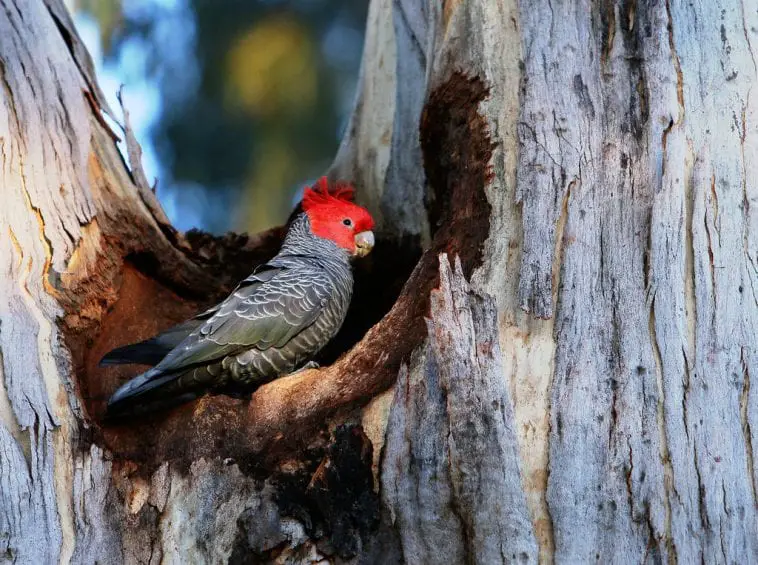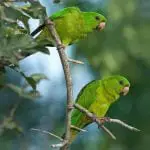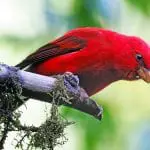Scientific Facts
| Common Name | Gang-gang Cockatoo |
| Scientific Name | Callocephalon fimbriatum |
| Origin | Coastal regions of south-eastern Australia |
| Habitat | Wetter forest and cooler woodlands, mountainous and bushland parts |
| Diet | seeds of different shrubs, native trees such as eucalypts, hawthorns, and wattles |
| Size | Insects, larvae, nuts, berries and other fruits |
| Life Span | Wild: 20-30 years Captivity: up to 50 years |
Physical Description
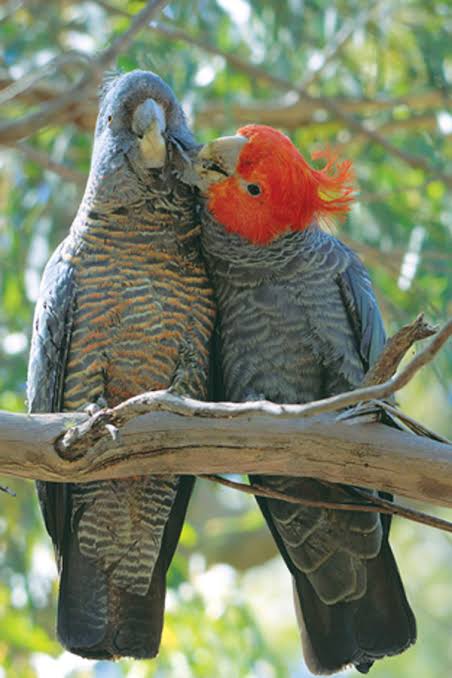
The name of the gang-gang cockatoo is an aboriginal language from New South Wales and is considered as an onomatopoeic word. In the wild, gang-gang cockatoos can be distinguished easily through their call, especially if they are in a flock with other bird species. Males and females differ in physical appearance significantly. The male Gang-gang cockatoo has a wispy red crest that stands out against their grey bodies; they were also given different names related to their physical appearances such as red-crowned cockatoo and a red-headed cockatoo.
The males tend to be covered in dark grey coloration with grey or white feathers, redhead, and a dark grey to black tail. While the females have a dark grey head and fluffy crest with upper parts of their body that have pale yellow and underparts with orange to yellow or green colorations with a tail that has a greyish or whitish coloration. In short, the males have a more vibrant coloration while the female has a duller color.
Where it is Seen?
They can be seen originating from the coastal regions of south-eastern Australia, but they use to inhabit Tasmania and King Island; however, nowadays, their population in that place is already extinct with this, they were introduced to Kangaroo Island, southern Victoria, central-eastern New South Wales. There were a lot of efforts to further distribute their population is some other parts such as the Australian Alps, Nandewar, NSW North Coast, NSW South Western Slopes, Ocean, South East Corner, South Eastern Highlands, and Sydney Basin.
Habitat
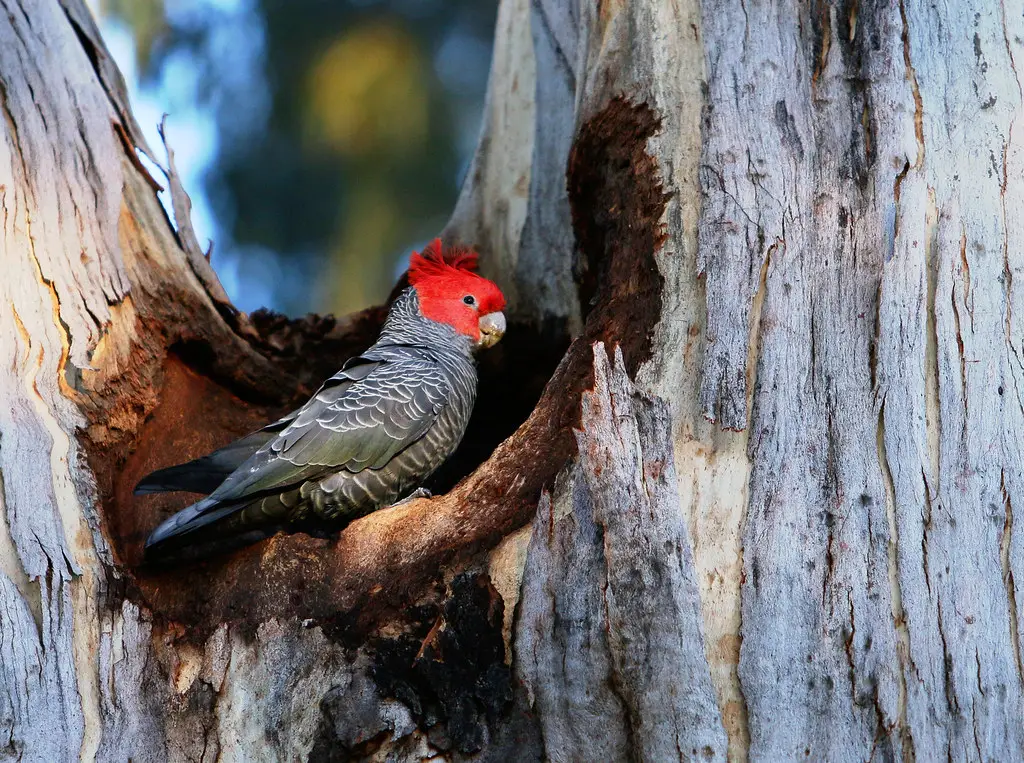
They mostly thrive in the wetter forest and cooler woodlands, mountainous and bushland parts of Australia. During the winter season, they would usually migrate to other places where there is a more friendly atmosphere for them, but as soon as the season changes, they’ll move back to their main habitat which is a dense forest where they can breed since they need the help of trees to breed. During the spring and summer season, they are mostly seen in woodlands and tall mountain forests that are highly timbered. During the winter and autumn season, they would go to lower altitudes for them to keep their bodies drier in open forest, usually in coastal areas in urban places. Their nests are located in hollows, which have at least 10 cm in diameter 9m above the ground of the tree where they are in.
Behavior and Temperament
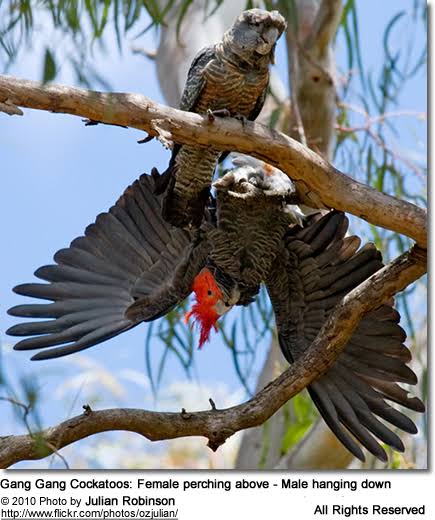
During the breeding season, they are usually seen in small groups only, but during their feeding time, they are seen in large flocks in their food or water source. They are arboreal birds where they would only go to the ground to eat and drink. They tend to be more active if it is raining or if there are snow showers where they tend to do aerobatics. They are a powerful flier that has the ability to fly long distances, but they would also do some short flights from one tree to another.
Breeding and Reproduction
Gang-gang cockatoos’ reproduction season is during the months of October to January. They are considered as sexually active when they are about 4 years old. They are known to be monogamous birds that have a pair that mate for life. The females have the ability to lay up to two white eggs where both parents incubate it for about 24-30 days. When these eggs hatch, they are fed by their parents for about 7-8 weeks, and it would take at least 4-6 weeks for them to develop their feathers and wings for them to fly, so in total, they have 12-14 weeks to be independent after they hatched. Every year, the parents would go back to the same tree where they nest to breed again.
Diet
In the wild, they usually eat the seeds of different shrubs, native trees such as eucalypts, hawthorns, and wattles. They also eat a variety of insects and larvae. Nuts, berries, and other fruits are considered as their favorite food. They are considered in the few lists of those birds who enjoy eating sawfly larvae in large quantities. A sign that they like what they are eating if they tend to have a soft growling sound as they eat.
Size
Gang-gang cockatoos are considered as a small bird species that has a length that ranges from 33 to 37 cm with a wingspan of about 63-76cm.
Life Span
In the wild, they have a life expectancy of about 20-30 years while in captivity, if they are under optimal conditions, their life span can reach up to 50 years. It is normal that the life expectancy of the bird in captivity is increased because the different factors that threaten their population are controlled.
Common Disease/ Illness
Psittacine beak and feather disease (PBFD)
This happens when the immune system and the cells that take good care of the beak and feathers are attacked by the virus. You know that your bird is suffering from this disease if the feathers change in color and if the feathers are dropping while the beak changes in shape and is fragile. This disease doesn’t have a known cure; that is why some birds who are suffering from this disease have a weakened immune system that is the cause of their death. It is important to let your bird be screened for PBFD before taking it into captivity.
Obesity and Lipomas
Most cockatoos that are taken into captivity are susceptible to obesity due to incorrect diet and since they only have a limited exercise. When they are obese or overweight, difficulty in breathing, stressed joints, and bones are experienced, and they are also prone to having diabetes, liver disease, and pancreatic disease. Benign fatty tumors, or known as lipomas, is another manifestation of obesity. This tumor is painful, especially when it grows large and the only way to remove it is through surgery, which is quite risky for your pet.
Bumblefoot
This is characterized by swelling and lameness of the cockatoo’s feet and is usually consists of lesions with a discharge. If your bird suffers from this condition, expect that they will have difficulty to land on the ground, stand on the porch, or even grasp their food or toys. Since the swelling of their feet is accompanied by lesions, make sure that their cage is hygienic to avoid infections. Bumblefoot is usually due to malnutrition, especially when there is Vitamin A or calcium deficiency.
Feather Picking and Self-mutilation
Feather Picking and self-mutilation are usually due to behavioral problems caused by boredom, stress, and sexual frustration. As soon as your bird learns this behavior, it can no longer be unlearned; that is why when you notice unusual behavior from your bird, take it immediately to your veterinarian. This behavior is usually triggered if your bird is lonely and bored; that is why it is always important to make them feel that they are not alone by playing with them, or you can have them in pairs.
Food poisoning/Ingesting toxins
Whether in the wild or in captivity, cockatoos are susceptible to food or toxin poisoning. Not all types of food are healthy to them; there are the kinds of foods that are toxins and may cause negatively on their health, such as avocados, grapes, peanuts. If your cockatoo ingested these toxic foods, they might suffer from the normal real stool, dizziness, liver disease, kidney problems, and heart failure. Inhaling toxic household chemicals is also dangerous for their health; that is why it is advisable not to use any household chemicals near them.
Preventing Illnesses
Some reasons why birds acquire diseases or illnesses because of some reasons such as unhygienic environment, stress, boredom, nutritional deficiencies, and due to the incorrect way of handling. Before taking gang-gang cockatoo in captivity, it is advisable to make sure that you are well equipped with knowledge on how to take good care of them. It is advisable to give them your 100% attention so that you could determine immediately if something is wrong with their health.
As soon as you notice that there is something wrong with your pet, you need to take them into your nearest veterinary. If they were taken directly from the wild, it is advisable to take them into the veterinarian first so that they could conduct a series of experiments to make sure that the bird is not a carrier of any disease and to ensure that they are in good health.
Captive Breeding
Gang-gang cockatoo is a common bird taken in captivity because they are friendly and intelligent by nature. They are also a hardy type of bird as long as you will give them the right care. In taking them into captivity, you must provide them with their basic needs, such as suitable housing, nutritious food, safe accessories, and proper way of handling.
Availability-Where to Get One
They are listed as least concern; that is why there are no restrictions in taking them into captivity. They are mostly seen in both reptile and mammal store. If you cannot find one in your place, you may search for a bird breeder on the internet. It is advisable to make sure that you are only purchasing from a legit breeder to ensure its quality and purity.
How to Care Parrot as a Pet?
Housing
It is always advisable to opt for larger cages if you decided to take this bird into captivity with at least 102 x 76 cm (40 x 30 inches). They are an active bird species; that is why a spacious cage where they can play around is important. The cage should be placed in a room with natural lighting since they want to get up with the sun; it can either be near the window or on your balcony. To give them the feeling that they are still part of the flock, make sure that their place is where they can see a lot of people.
Accessories
There should be a lot of perches spaces throughout the cage where they can move around hopping. The ideal would be at least 4-5 perches in a large cage. They would usually sleep near the top part of the cage, so place a soft perch in it.
Include lots of perches spaced throughout the cage. Put these at various heights so your bird can hop around. Make sure to include at least 4-5. They can all be the same type of perch, except pick a soft perch for the one nearest the top of the cage. If they stay alone, they need a lot of toys to keep them entertained.
Feeding
In captivity, they are usually given pellet that is enriched with nutrients that they needed. The amount of food that you will be giving your bird should depend on their size. Ideal food preparation for them should be at least 75% consist of pellets, while 20% consists of fresh fruits, legumes, and grains. They are voracious eaters, so discover what kind of combination is their favorite. Giving them a variety of foods will ensure that they are getting sufficient nutrients daily.
You can choose from different fruits such as apples, peaches, bananas. The different vegetables such as squash, peas, carrots, cabbage, tomatoes, cucumber, etc. You can also give them cooked food such as brown rice, pasta, navy beans, barley, oats, and kidney beans. Make sure not to give them too many citrus foods such as kiwi, broccoli, and strawberries along with pelleted foods because when combined, it absorbs high iron that leads to other deficiencies. They will have an appetite to eat more if someone is around them.
Grooming
The gang-gang cockatoo easily gets irritated; that is why it is important to do grooming. You need to bathe or shower them at least once a week. Most species of cockatoos especially the gang-gang cockatoos are fond of water, sometimes they even dive into the bowl of their drinking water that is why it is important to give them a water bowl that only has a sufficient water for drinking because they can drown for only a couple of inches deep and that they are not good at swimming.
A proper way for you to bathe them is through the use of a showerhead or a can with small holes. To know if your bird is comfortable with water, just sprinkle them a little bit first, if they show some signs of aggressiveness, it means that they do not like to take a bath so don’t force it. Apart from bathing them, you also need to trim their claws and nails. Some pet owners are not comfortable doing it, so you may visit your veterinarian to groom them safely and correctly.
Facts About Gang-gang Cockatoos
- They have a big role in dispersing seeds in different places.
- Gang-gang cockatoos do long call screeches like a rusty hinge. They make this sound during flight or while they stay on the treetop.
- They eat their food while holding their food with their one foot while they open it with their bill while using their tongue and lower mandible to take it out, especially if their food is fruits with covering.
- Gang-gang cockatoos are fond of chewing to keep them entertained.
- They growl softly while eating. They communicate by means of gr-rare-risk or er-eck sound. This is an indication that these bird species are gregarious and loud.
Conservation Status
There are a couple of reasons why there is a threat to their population, such as loss of breeding sites due to wildfire, climate change, disease infestations, and the threat from their predator. Good thing, even though there are some threats to their population, they are still classified as Least Concern (LC) according to the IUCN Red List with over 10,000 and more mature gang-gang cockatoo.
FAQ Section
Why does my Cockatoo pluck its feathers out of its chest?
When your cockatoo plucks its feathers, especially on the chest, if they are bored, stressed, and unhappy. Make sure your bird doesn’t get this behavior because when they learn this habit, it can no longer be broken.
Can I keep my cockatoo under the sun?
Daylight is necessary for their digestive functioning and for them to be healthy.
Do cockatoos need a lot of attention?
They need a lot of attention, especially in captivity. If they get bored, there are high chances that they will develop bad habits.
How to distinguish if my cockatoo is a female or male?
The male and female cockatoo is distinguished through their eye color. The males have black eyes while the females have brown eyes.
Can two cockatoos work well in a pair?
This type of cockatoo loves socializing. In captivity, it is advisable to take a pair of cockatoos if you do not have so much attention that the bird demands so that they don’t develop bad habits.
My cockatoo’s feet are too dry, is there something to worry about?
If your cockatoo’s feet are dry, you’ll just have to rub oil, preferably coconut oil on the dry part to get moisturized.
Can I give cockatoo, who is four months old fresh fruits and vegetables?
You can already give them fresh fruits and vegetables but don’t overfeed them. Just give a couple of small pieces.
What are the best temperatures for cockatoos?
The ideal temperature is at room temperature. They do not like too much heat unless they are sick, where they need to stay under the lamp.
It is necessary to apply oil on the Gang-gang cockatoo on feet and beak?
It is not necessary, but it is advisable to apply at least a small amount of oil to its beak and feet, especially after showering them to avoid brittleness.

